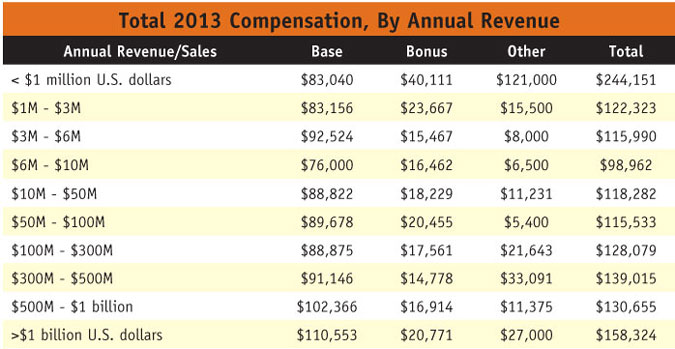Still on the upswing
It’s hard to believe that Quirk’s has just wrapped up its fifth-annual salary survey of client-side researchers. It feels like just yesterday we received our first batch of responses in 2009 and now we have half a decade’s worth of data to reflect on. The 2013 survey yielded our largest respondent pool yet, with a total of 1,290 full-time client-side researcher participants – and arguably our most optimistic data.
Having debuted this ongoing study at the height of the Great Recession, it’s been interesting to follow how both salaries and outlooks have evolved along with the state of the national and global economy. For the most part, the data over the years has served as a beacon of hope – reminding us that no matter how nihilistic the views of research naysayers may be, the reality of the situation in the eyes of corporate researchers was never quite as bad as was portrayed within the industry or in the media.
While the research industry went through bouts of dissatisfaction in the workplace (2011, specifically) and rashes of wanting to change jobs (again, 2011), client-side researchers have largely toughed it out and are now only the better for it, as the 2013 data shows the highest level of job satisfaction to date, at 75 percent (19 percent somewhat satisfied; 37 percent satisfied; 19 percent very satisfied). Still, as in previous years, money cannot buy happiness in the MR community, as the highest earners are somewhat dissatisfied with their current employment ($150,560) and the second-highest earners are very dissatisfied ($149,225). The lowest earners reported being somewhat satisfied ($124,379).
Best news of all
But corporate researchers have good reason to be as satisfied as ever. Maybe the best news of all for 2013 is that salaries are generally higher across all industries, regions and titles. In 2012, the average total salary hovered around $124,000. This year? $144,000. That’s an almost-14 percent lift in one year, suggesting that compensation is finally catching up with the stronger economy. The largest jump in any one category is that of those researchers who identify as owners/partners, whose salaries rose to $448,944 from $293,818 in 2012 (the first year we included this exact category).
Again, senior vice presidents and vice presidents are earning significantly more than presidents/CEOs/COOs. We called out this discrepancy in our 2012 report and upon further investigation, we found that the sample of respondents with the title president/CEO/COO in 2013 was significantly smaller than that of senior vice presidents and vice presidents (three respondents compared to 71, to be exact). This has perplexed us in previous years and now on our fifth iteration, we are confident in attributing this outlying data point to an inadequate/unequal sample.
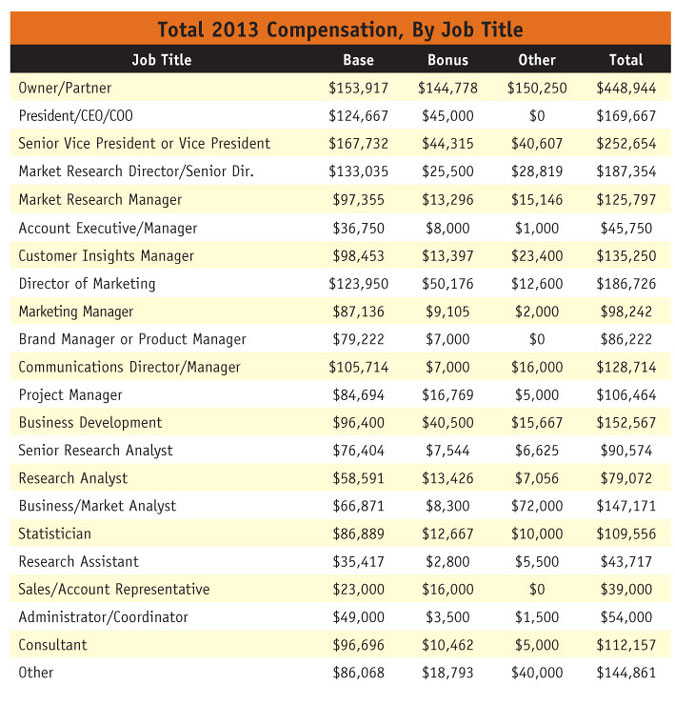
Mammoth increases
By industry, 2013 saw mammoth increases in three sectors: automotive, computer hardware/software and technology/IT/Web. Perhaps as a testament to the overall recovery of the automotive industry since the bailout of 2008-2009, the average salary for a corporate researcher in the automotive sector jumped to $209,028. The second-highest salary recorded in this industry was $151,582 in 2009. In the intermediate years, the average salary for automotive researchers hung around $125,000.
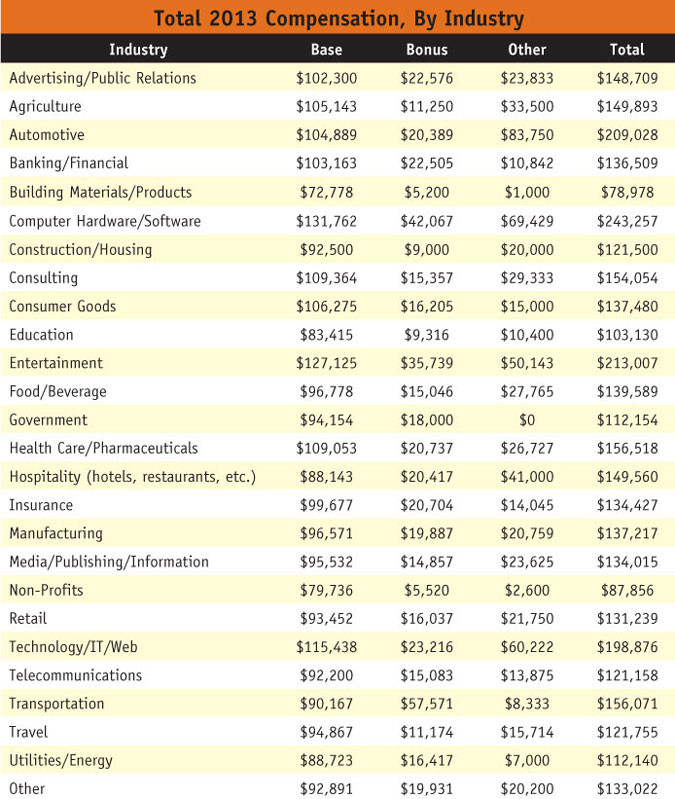
The salary progression in the other two categories is probably less surprising, given the advances in – and rapid adoption of – technology over the past five years. The 2013 average in the computer hardware/software industry is $243,257 (the highest in any industry), up from $134,765 in 2012; $101,517 in 2011; $101,077 in 2010; and $113,373 in 2009. A similarly dramatic trend is evident in the technology/IT/Web sector, as the average salary has steadily increased from $82,809 in 2009 to $198,876 in 2013. Not a bad trajectory!
In the lurch
Geographically speaking, the highest salaries are still found on the coasts, as corporate researchers along the East Coast are the highest domestic earners, followed by those on the West Coast. Last year the Midwest and the Rocky Mountain states were roughly tied for the lowest domestic salaries but this year the Midwest pulled ahead to $122,240, leaving the Mountain states in the lurch at $107,319, which, however, is still a very slight increase over the 2012 figure of $103,322.
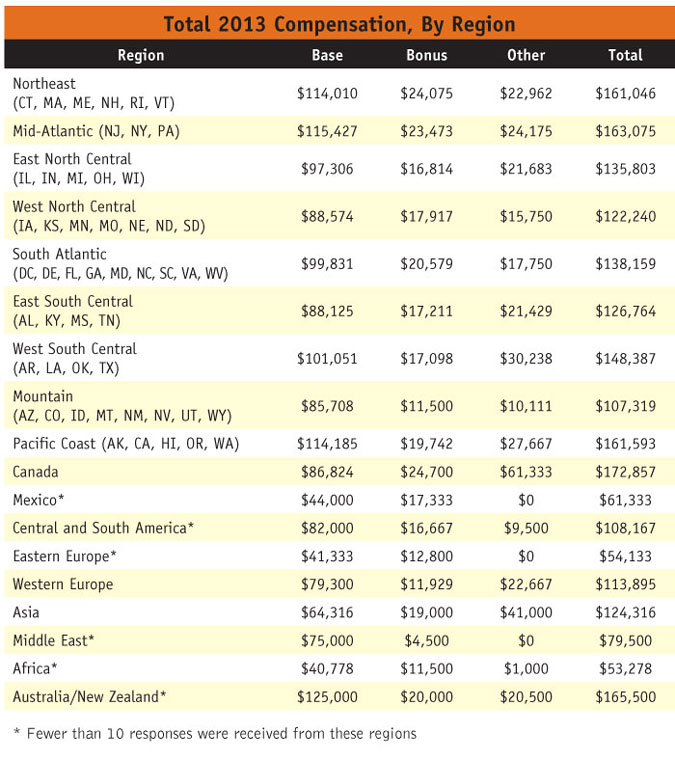
Internationally, of the countries/regions that generated more than 10 responses, Canada and Asia experienced the greatest deviation from previous years – favorable for Canada, dismal for Asia. In Canada, the average salary increased from $98,926 in 2012 to a whopping $172,857. Asia, on the other hand, decreased from $141,316 in 2012 to $124,316 in 2013.
Generally, as in all previous years, researchers with more experience and higher degrees can expect to continue to earn more as they age, as the highest salaries are found among those over 66 years old and with over 25 years of experience and/or a Ph.D. While there is some fluctuation in salary among those with less than one-to-two years of experience, as we’ve seen in previous years, it’s safe to say that tenure and educational development within the research industry pay off in spades.
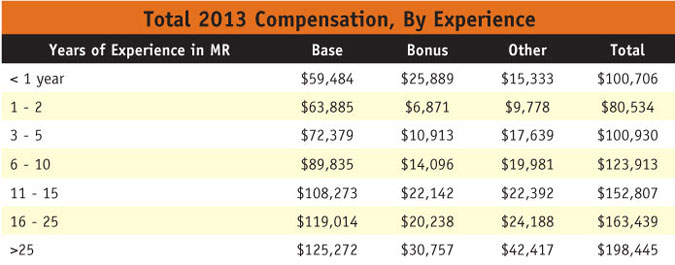

The improving job market
Even as the economy continues to recover each year, researchers aren’t looking to take advantage of the improving job market. Roughly the same percentage of respondents said that they are somewhat unlikely (12 percent), unlikely (19 percent) or very unlikely (22 percent) to seek employment at a different company in 2013 as they were in 2012 (53 percent vs. 54 percent, respectively). This continues to be a huge improvement over those looking to change jobs in 2010 and 2011. By comparison, only 44 percent were somewhat unlikely, unlikely or very unlikely to seek new employment in 2011.
Oddly enough, as client-side researchers are more and more content to stay put, more companies are expected to hire additional market research employees in 2013 than ever before. So this could be good news for those looking for a new position as the candidate pool dwindles and job openings increase. For reference, in 2010, 33 percent of respondents said their company was somewhat likely, likely or very likely to hire additional MR employees; 37 percent in 2011; and 38 percent in 2012. This year, the figure jumped another four points to 42 percent, which is well outside the study’s margin of error. Specifically, 14 percent said it is very likely that their company would hire additional MR employees, 11 percent likely and 17 percent somewhat likely.
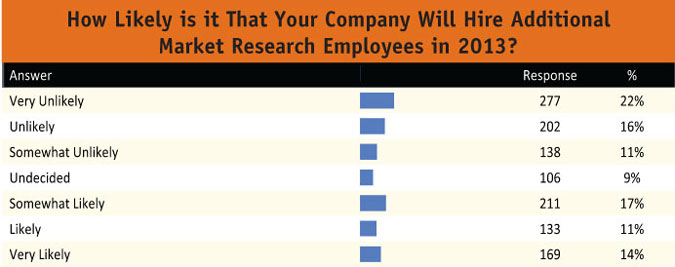
Generally speaking, the amount of time researchers spent conducting or coordinating and analyzing research has remained relatively steady over the past five years, with 40-44 percent of respondents spending 75 percent or more of their time dedicated to MR. For the past five years, the percentage of researchers who report working the same amount or more has hovered around 60 and 35 percent, respectively. So each year a little over one-third of researchers are adding more hours to their workweek.
Once more, the plurality of respondents identify as market research managers (30 percent), followed distantly by market research director or senior director (18 percent). And these MR managers and directors are part of tiny teams, as the majority of respondents (52 percent) are on a team of one-to-five full-time MR employees and 54 percent are not responsible for supervising any employees. This figure regarding management has remained steady over the history of the survey but jumped from under half to over half for the first time in 2012.
Ahead of inflation
Over three-quarters of respondents said that their base salary for 2013 increased over the previous year, which is in line with the data from 2012. Over 56 percent received a base salary increase of 1-4 percent, which is at least enough to stay ahead of inflation.
Approximately one-third of client-side researchers enjoyed a bonus increase and approximately 81 percent reported that their 2013 bonus increased or stayed the same. Nearly 20 percent reported a bonus decrease, which is in keeping with 2012 numbers but still a disappointing jump over the 10 percent in 2011 who said that their bonus decreased.
For the first time, we’re seeing many researchers saying that they are in new positions too fresh to compare to last year or to have warranted a raise or bonus. Perhaps those 34 percent last year who said they were considering pursuing new employment were successful!
“I assumed a new role at the end of 2012.”
“New employee – no bonus or dividends yet.”
“I started in November 2012 so it’s too early for bonuses or dividends.”
“I just started working for the company. I did not receive a bonus or corporate options in 2012 but will in 2013.”
“I have been at this job for only three months – straight out of grad school. This is my first year so increase in bonus does not apply.”
“I started a new job in January of 2013. I will be getting stock options but don’t know to what level at this point.”
Finally opening up
In past years, we’ve asked respondents what they like most about working in MR, what they like least, what the biggest challenges facing the industry are and what skill set marketing researchers will need to possess in the coming years. With all the talk of the job market finally opening up and the increasing likelihood of companies looking to increase MR staff, this year we were curious to see how respondents came to be employed at their current companies. And lest you think that the results are skewed by researchers who’ve been in the same position since long, long before the advent of social media and the influx of networking events, consider the trend noted earlier regarding respondents too new in their positions to have past salary data to compare to!
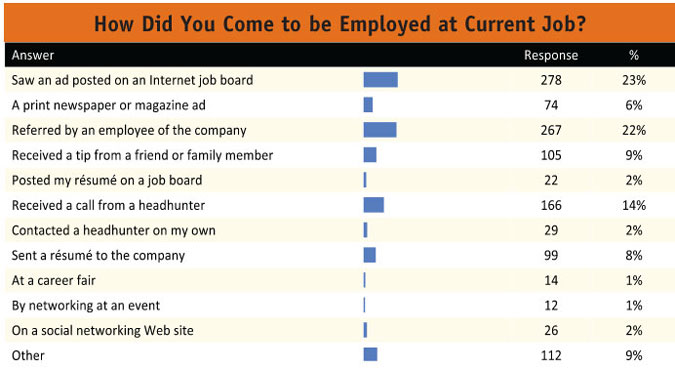
While recent data have indicated that social media is being used more and more to post jobs and find talent, a mere 2 percent of respondents found their current position via social media. Only 2 percent had success at a career fair or networking event but personal networking in general is one of the most powerful influencers. Personal referrals by an employee within the company or a tip from a friend or family member were two popular methods of finding employment at 22 and 9 percent, respectively. Turns out it really is all about who you know!
Still, the most reliable way to find employment is using an Internet job board (23 percent), which isn’t surprising as the Jobs section on Quirks.com is one of the most-visited areas of our Web site! And as far as posting ads goes, employers would be wise to rely on the Internet and not a print newspaper or magazine, as Internet postings beat out print ads by 17 percent.
Another 14 percent were fortunate enough to be contacted by a headhunter and 2 percent reached out to a headhunter on their own. Fortunate because those who received a call from the headhunter about a position earn on average over $173,000, which is almost $14,000 more than the next-highest-paying methods (referral from friend or family member and social networking) and almost $30,000 more than the average salary among corporate researchers. Conversely, the unfruitful career fairs and networking events seem to be doubly so, as these methods yielded the lowest salaries by a wide margin, at $105,486 and $101,417, respectively.
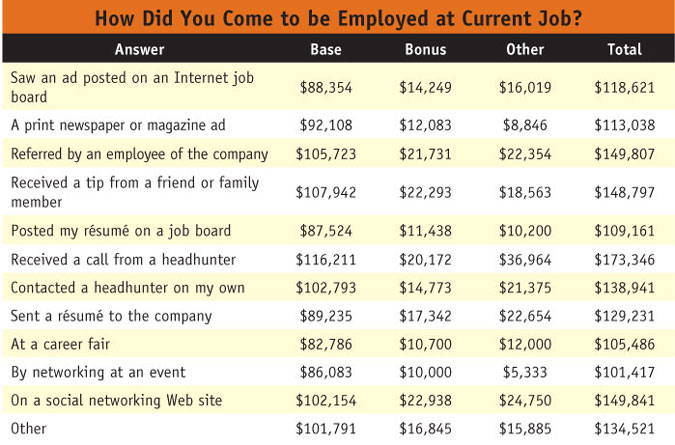
Take the advice
Finally, we may want to take the advice of the many, many articles we’ve published regarding mobile research and the importance of mobile compatibility and revisit how we design next year’s salary survey, as there were several complaints about it not being mobile-friendly! Apologies!
“Slider hard to use on cell phone.”
“Slider doesn’t work well on mobile device.”
“This page is ridiculously hard to fill out using an iPhone.”
Happy to report
After five years of data, it's clear that the research industry is as strong as ever and growing in all the right ways. We’re happy to report that corporate researchers seem to be flourishing in their positions and we hope to see our readers continue to find satisfaction – and growing salaries – in the years to come.

